Excerpts from Jim Conrad's
Naturalist Newsletter
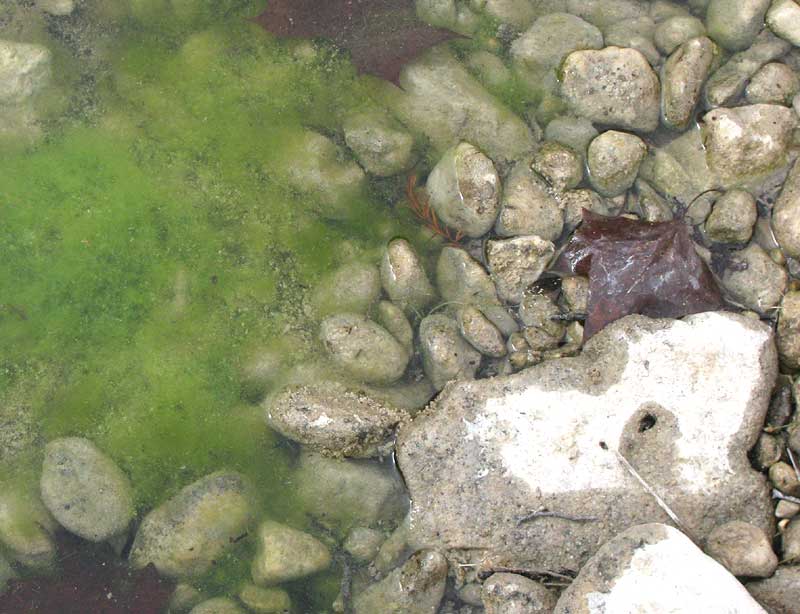
from the November 25, 2012 Newsletter issued from the valley of the Dry Frio River in northern Uvalde County, southwestern Texas, on the southern border of the Edwards Plateau; elevation ~1750m (~5750 ft); N29.62°, W99.86°; USA
ZYGNEMA ALGA
We've seen that the quiet waters pooled along our little Dry Frio River running behind the cabin contain the green alga Spirogyra, with its strands of chloroplasts spiraling elegantly through its fairly transparent cells. Our neat microscopic image of Spirogyra with its spiraling chloroplasts is at https://www.backyardnature.net/n/x/spirogyr.htm.
Thing is, the Spirogyra filament in that picture was found in open water, so I never got to learn what a colony or mass of Spirogyra looks like in its natural environment. I read that it looks like bright green fuzz in shallow water, so when I saw such a thing in a stagnant pool along the Dry Frio this week -- shown above -- I figured it was Spirogyra.
Before fixing in my mind that this was what a colony of Spirogyra looked like in the field, however, I knew I needed to confirm the identification by looking at the alga under the microscope. Once the filaments were under the microscope I did indeed see Spirogyra, but Spirogyra was only part of a mixture of very different looking filaments. Maybe 90% of them looked like what you can see below:
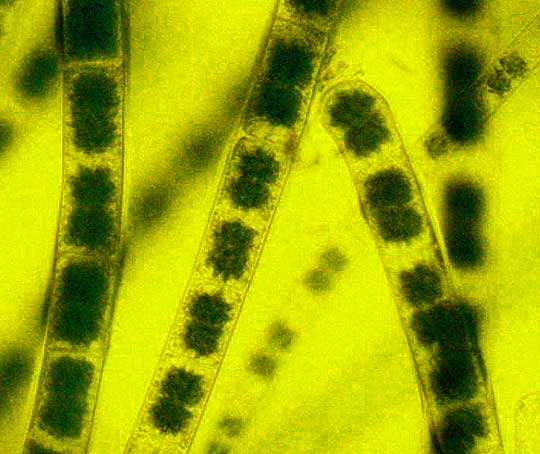
There's a tremendous difference in appearance between this and Spirogyra. However, even seeing what's in the photo, I wasn't willing to give up on the idea that I was seeing Spirogyra. That's because when sexual reproduction -- the act of conjugation -- takes place in Spirogyra, a dark, spherical zygospore is formed. The zygospore is tough and can overwinter to germinate in the spring into a new filament.
However, in Spirogyra only one zygospore forms per cell. You can see in our picture that each cells contain two dark blobs. Also, Spirogyra zygospores seen under a microscope appear to have smooth surfaces, while the dark blobs in our green-fuzz alga seem to have "spiky-hairy" or fibrous surfaces.
Finally deciding that this wasn't Spirogyra, I did a general image search on "green filamentous algae fuzzy" and eventually came upon pictures matching ours. What we have here is the genus ZYGNEMA, described as a free-floating mass of filaments forming a yellow-green to bright green, tangled mat. Each algal cell contains two chloroplasts arrayed one after the other along the axis of the cell. Often the chloroplasts are described as "star shaped," or stellate, in an attempt to say that the surfaces look spiky-hairy, as in our photo.
Zygnema is actually a rather common freshwater alga and often it's found growing with Spirogyra. About a hundred Zygnema species are recognized but even specialists have a hard time distinguishing them. Often when studies are done on eutrophied bodies of water -- waters in which pollution acts as fertilizer, causing a population explosion among algae, which affect the water's oxygen content and sedimentation rate -- Spirogyra and Zygnema are mentioned as prominent species involved with the eutrophication.
from the January 12, 2014 Newsletter issued from the Frio Canyon Nature Education Center in the valley of the Dry Frio River in northern Uvalde County, southwestern Texas, on the southern border of the Edwards Plateau; elevation ~1750m (~5750 ft); N29.62°, W99.86°; USA
FLOWING ALGA
In the Dry Frio, what's the yellowish-green alga whose long filaments anchor on the streambed and get carried downstream by the current, gracefully draping around rocks, as shown below:
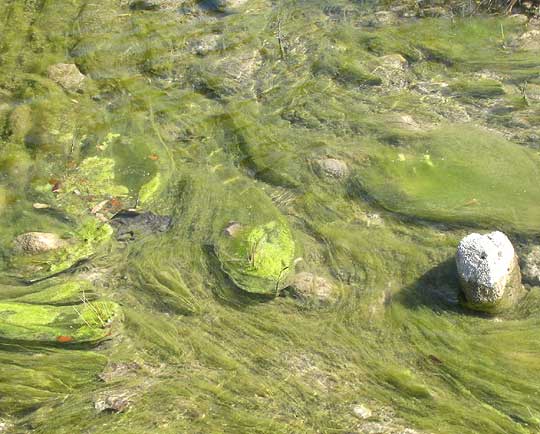
Beneath the microscope back at Juniper House the filaments reveal themselves as what's seen below:
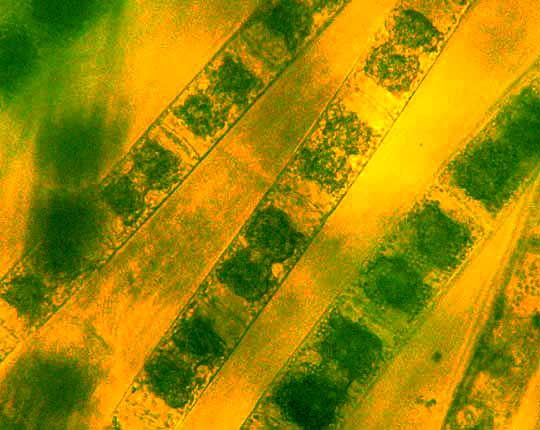
With each cell containing two photosynthesizing chloroplasts, and some of the chloroplasts displaying jagged edges, we've seen this very distinctive species before, not realizing then that it could form these flowing strands.
This is Zygnema, a commonly occurring freshwater alga, so its presence here is to be expected. About a hundred Zygnema species are recognized.
from the February 23, 2014 Newsletter issued from the Frio Canyon Nature Education Center in the valley of the Dry Frio River in northern Uvalde County, southwestern Texas, on the southern border of the Edwards Plateau; elevation ~1750m (~5750 ft); N29.62°, W99.86°; USA
GREEN SCUM TURNING RED
With warmer weather more algae are returning to the little Dry Frio River, though it's contained a good bit all winter. Some algae species encrust rocks and aquatic plants, some form long, green strands trailing downstream, other species form submerged, basketball-sized masses, and others create blobs of bubbly scum floating at the water's surface. This week it was a scum blob bubbly with photosynthesized oxygen that caught my attention. That's it below:
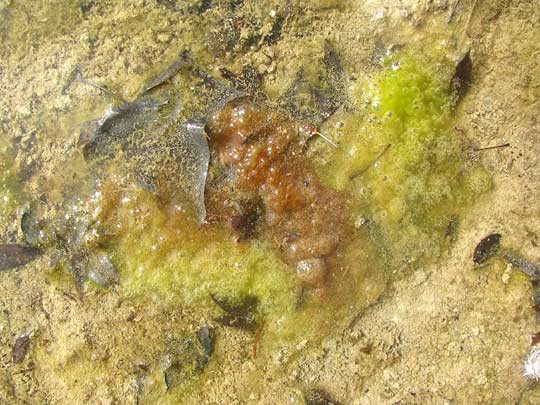
What's interesting is that this otherwise green or greenish yellow alga has a reddish part. Until now I've not seen such reddishness in such a greenish blob, so I guessed that the reddish area consisted of algal cells that were under stress, or maybe coming to the end of their life cycle. I transferred some of the red part and some of the green part to a container, took the collection to Juniper House, and looked under the microscope.
The green part was composed mostly of filaments of Zygnema alga and maybe 20% of Mougeotia alga, which we document at, at https://www.backyardnature.net/n/x/mougeoti.htm.
Examining the red part of the scum I found what's shown below:
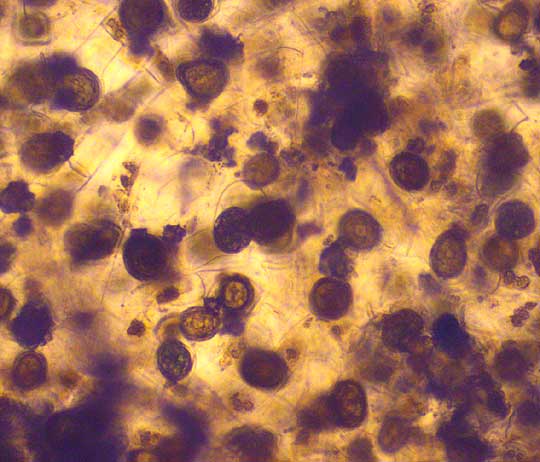
The spherical things are zygospores. Two algal filaments of different mating strains come into physical contact, the filaments' cell walls bulge toward one another at the point of contact, the bulges fuse and a tube forms between the two filaments. Genetic material from cells in both filaments flows into the connecting tube and sexually combines to form a zygospore. Eventually the zygospore breaks from the now-empty filaments, drops to the stream floor, and later germinates to form a new filament. This form of sexual reproduction is known as conjugation. In the picture not only do we see masses of zygospores but also some of the discarded, empty parent filaments.
Once I understood that the red part of the green scum consisted of zygospores and discarded filament sheaths, I began surveying the slide, looking for conjugation taking place. An interesting peep into this alga's conjugal life did turn up, shown below:
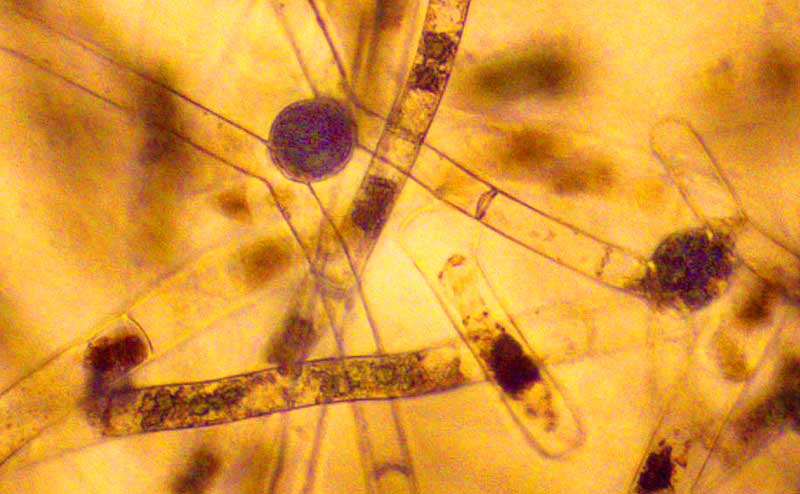
The zygospore at the top, left is fully formed and ready to disassociate from its two empty parent filaments. At the far right another zygospore hasn't yet completely formed and you can see dark areas inside both parent filaments where material still is streaming into the zygospore tube. In the picture's lower, left corner, another zygospore is just beginning to form, with most of the material destined for making it still inside the parent cells, but a small part of it already in the tube between the filaments.
So, how about that? Who'd have thought that such fascinating stuff could be going on in the little Dry Frio these days?